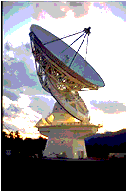SETI Searches Today
Several large searches for extraterrestrial intelligence (SETI) are currently scanning the stars, looking for both radio and laser transmissions from other civilizations. Considering the size of our galaxy, the immense distances between stars, and the width of the microwave spectrum, it's a daunting task even to search for beacons that are designed to help us out. SETI projects have advanced far in recent years, but we are still looking for needles in very big haystacks that remain mostly unexplored.
Here is a rundown of all the major SETI efforts, both radio and optical, that are currently under way worldwide.
 Project Phoenix
Project Phoenix
Run by the SETI Institute of Mountain View, California, Project Phoenix is the
search on which the 1997 movie Contact was loosely based. Phoenix is a
"targeted search." That is, it performs a sensitive examination of a relatively
few targets: a list of 1,000 mostly solar-type stars that are closer than 200
light-years and older than 3 billion years (when their ages can be judged), as
well as the very closest stars regardless of their type.
Using a truck trailer filled with custom-built equipment and computers, Project Phoenix has traveled to large radio telescopes around the world to monitor its chosen stars. It scans more than two billion channels between 1.2 to 3.0 GHz.
In 1995 Project Phoenix used the 64-meter dish at Parkes Observatory in Australia to observe 200 stars not visible from the Northern Hemisphere. In September 1996 it moved to the National Radio Astronomy Observatory in West Virginia to share time on a 43-meter dish. Then in 1998 it moved to the 305-meter Arecibo radio telescope in Puerto Rico, the world's largest, where it remains encamped today. Phoenix is scheduled to continue at Arecibo with a run of 20 daily sessions of 12 hours each about every six months until 2003.
Strengths: Nearby stars get examined in greater depth than by any other program. It can detect pulsed and drifting signals.
Weaknesses: Phoenix looks at only a few stars out of the billions in our galaxy. And it is "on the air" for only about 5 percent of each year.